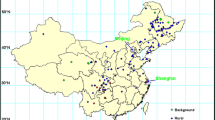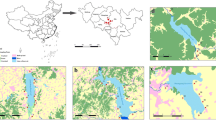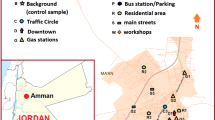Abstract
The Hexi Corridor is the main commodity grain base in northwest China and plays a special role in ensuring food security in northwest China. However, the multiple pollution transport pathways of PAHs and complex and co-existing potential pollution sources around the study areas require a combination of pollution status, source identification, and risk assessment to explore pollution distribution and potential risks. In this study, the total PAHs concentration (∑18PAHs) in soils ranged from 69.6 to 1300 ng/g. Spatially, the higher content of PAHs was detected in the Jinchang, followed by Jiayuguan, Jiuquan, Wuwei, and Zhangye, indicating a remarkable influence of different industrial activities. Although high-molecular-weight PAHs were predominated, the compositions of PAHs in most of the soil samples were varied. The isomer ratios of PAHs and principal component analysis were also revealed the PAHs probably originate from the sources different significantly. The total health risk values indicated a low health risk.




Similar content being viewed by others
References
Abdel-Shafy HI, Mansour MSM (2016) A review on polycyclic aromatic hydrocarbons: source, environmental impact, effect on human health and remediation. Egypt J Pet 25:107–123
Bolden AL, Rochester JR, Schultz K et al (2017) Polycyclic aromatic hydrocarbons and female reproductive health: a scoping review. Reprod Toxicol 73:61–74
Collins JF, Brown JP, Alexeeff GV et al (1998) Potency equivalency factors for some polycyclic aromatic hydrocarbons and polycyclic aromatic hydrocarbon derivatives. Regul Toxicol Pharmacol 28:45–54
Dai J, Li S, Zhang Y et al (2008) Distributions, sources and risk assessment of polycyclic aromatic hydrocarbons (PAHs) in topsoil at Ji’nan city, China. Environ Monit Assess 147:317–326
Fraser MP, Cass GR, Simoneit BRT et al (1997) Air quality model evaluation data for organics. 4. C2–C36 non-aromatic hydrocarbons. Environ Sci Technol 31:2356–2367
Guan QY, Wang FF, Xu CQ et al (2018) Source apportionment of heavy metals in agricultural soil based on PMF: a case study in Hexi Corridor, northwest China. Chemosphere 193:189–197
Jiang YF, Wang XT, Wang F et al (2009) Levels, composition profiles and sources of polycyclic aromatic hydrocarbons in urban soil of Shanghai, China. Chemosphere 75:1112–1118
Jiang YF, Yves UJ, Sun H et al (2016) Distribution, compositional pattern and sources of polycyclic aromatic hydrocarbons in urban soils of an industrial city, Lanzhou, China. Ecotoxicol Environ Saf 126:154–162
Jiang YF, Yuan LM, Wen H et al (2020) Distribution, composition, sources, and potential ecological risks of PAHs in the sediments of the Lanzhou reach of the Yellow River, China. Bull Environ Contam Toxicol 105:613–619
Kavouras IG, Koutrakis P, Tsapakis M et al (2001) Source apportionment of urban particulate aliphatic and polynuclear aromatic hydrocarbons (PAHs) using multivariate methods. Environ Sci Technol 35:2288–2294
Khalili NR, Scheff PA, Holsen TM (1995) PAH source fingerprints for coke ovens, diesel and gasoline engines, highway tunnels, and wood combustion emission. Atmos Environ 29:533–542
Kim KH, Jahan SA, Kabir E et al (2013) A review of airborne polycyclic aromatic hydrocarbons (PAHs) and their human health effects. Environ Int 60:71–80
Liu ZY, He LX, Lu YZ et al (2015) Distribution, source and ecological risk assessment of polycyclic aromatic hydrocarbons (PAHs) in surface sediments from the Hun River, northeast China. Environ Monit Assess 187:1–10
Malcolm HM, Dobson S (1994) The calculation of an environmental assessment level (EAL) for atmospheric PAHs using relative potencies. Department of the Environment, London, pp 34–46
Maliszewska-Kordybach B (1996) Polycyclic aromatic hydrocarbons in agricultural soils in Poland: preliminary proposals for criteria to evaluate the level of soil contamination. Appl Geochem 11:121–127
Mao XX, Yu ZS, Ding ZY et al (2016) Sources and potential health risk of gas phase PAHS in Hexi Corridor, Northwest China. Environ Sci Pollut Res 23:2603–2612
Nisbet C, LaGoy P (1992) Toxic equivalency factors (TEFs) for polycyclic aromatic hydrocarbons (PAHs). Regul Toxicol Pharmacol 16:290–300
Notar M, Leskov EH, Faganeli J (2001) Composition, distribution and sources of polycyclic aromatic hydrocarbons in sediments of the Gulf of Trieste, Northern Adriatic Sea. Mar Pollut Bull 42:36–44
US EPA (1993) Provisional guidance for quantitative risk assessment of polycyclic aromatic hydrocarbons. US Environmental Protection Agency, Research Triangle Park, EPA600/R-93/089.
Rogge WF, Hildemann LM, Mazurek MA et al (1993) Sources of fine organic aerosol. 2. Non-catalyst and catalyst-equipped automobiles and heavy-duty diesel trucks. Environ Sci Technol 27:636–651
Simcik MF, Eisenreich SJ, Lioy PJ (1999) Source apportionment and source sink relationships of PAHs in the coastal atmosphere of Chicago and Lake Michigan. Atmos Environ 33:5071–5079
Tang L, Tang XY, Zhu YG et al (2005) Contamination of polycyclic aromatic hydrocarbons (PAHs) in urban soils in Beijing, China. Environ Int 31:822–828
Tsai PJ, Shih TS, Chen HL et al (2004) Assessing and predicting the exposures of polycyclic aromatic hydrocarbons (PAHs) and their carcinogenic potencies from vehicle engine exhausts to highway toll station workers. Atmos Environ 38:333–343
Valavanidis A, Fiotakis K, Vlahogianni T et al (2006) Characterization of atmospheric particulates, particle-bound transition metals and polycyclic aromatic hydrocarbons of urban air in the centre of Athens (Greece). Chemosphere 65:760–768
US EPA (1991) Risk assessment guidance for superfund: volume 1. Human health evaluation manual (Part B, Development of risk-based preliminary remediation goals). OSWER, [9285.7–01B. EPA/540/R-92/003].
Wang XT, Jia Y, Sun ZY et al (2010) Distribution, source and ecological risk of PAHs in surface sediments of rivers in typical polluted areas. Environ Sci 31:153–158 ((in Chinese))
Wang CH, Wu SH, Zhou SL et al (2017) Characteristics and source identification of polycyclic aromatic hydrocarbons (PAHs) in urban soils: a review. Pedosphere 27:17–26
Wilcke W (2007) Global patterns of polycyclic aromatic hydrocarbons (PAHs) in soil. Geoderma 141:157–166
Yunker MB, Macdonald RW, Vingarzan R et al (2002) PAHs in the Fraser River Basin: a critical appraisal of PAH ratios as indicators of PAH source and composition. Org Geochem 33:489–515
Zhang P, Chen YG (2017) Polycyclic aromatic hydrocarbons contamination in surface soil of China: a review. Sci Total Environ 605–606:1011–1020
Zhang ZC, Pan KJ, Zhang CX et al (2020) Geochemical characteristics and the provenance of aeolian material in the Hexi Corridor Desert, China. Catena 190:104483
Acknowledgement
This work was financially supported by the National Natural Science Foundation of China (No. 21966020) and the Gansu Province Science and Technology Support Program (No. 20JR5RA392).
Author information
Authors and Affiliations
Corresponding author
Additional information
Publisher's Note
Springer Nature remains neutral with regard to jurisdictional claims in published maps and institutional affiliations.
Rights and permissions
About this article
Cite this article
Jiang, Y., Yuan, L., Liang, X. et al. Status, Sources and Potential Risk of Polycyclic Aromatic Hydrocarbons in Soils from Hexi Corridor in Northwest China. Bull Environ Contam Toxicol 108, 563–570 (2022). https://doi.org/10.1007/s00128-021-03312-6
Received:
Accepted:
Published:
Issue Date:
DOI: https://doi.org/10.1007/s00128-021-03312-6




